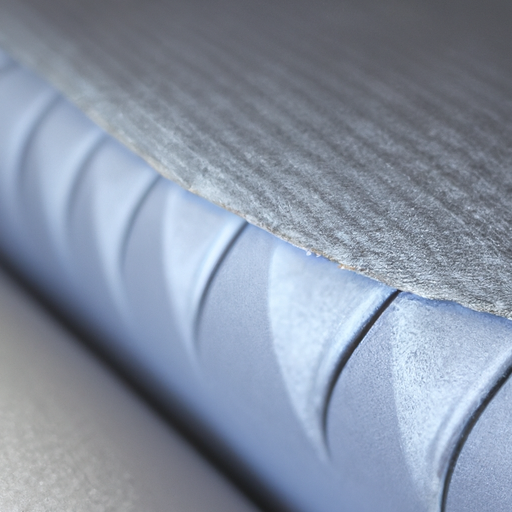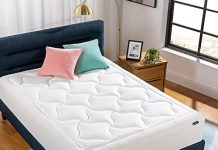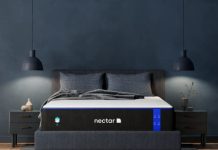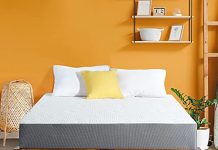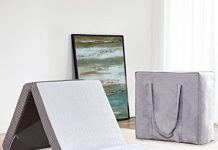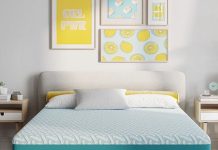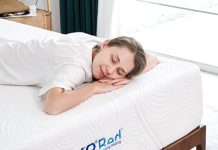Curious about the materials used in roll up mattresses? Look no further! In this article, we will explore the common materials that are often used in the production of these convenient sleep solutions. From memory foam to pocket springs, we’ll uncover the secrets behind creating a comfortable and compact mattress that can be easily rolled up for transport and storage. Stay tuned to discover the innovative materials that make roll up mattresses both practical and comfortable.
Review contents
1. Foam-based materials
At the top of the list of materials commonly used in roll-up mattresses are foam-based materials. This category includes memory foam, polyfoam, and latex foam.
1.1 Memory Foam
Memory foam is a popular choice for roll-up mattresses due to its ability to contour to the body and provide excellent pressure relief. Made from a viscoelastic material, memory foam responds to body heat and weight, molding to the shape of the sleeper. This material is known for its ability to alleviate pressure points and provide a comfortable and supportive sleep surface.
1.2 Polyfoam
Polyfoam, short for polyurethane foam, is another foam-based material commonly used in roll-up mattresses. It is known for its versatility and affordability. Polyfoam can be found in different densities, often categorized as high-density foam or low-density foam. High-density polyfoam provides a firmer and more durable support, while low-density polyfoam offers a softer feel.
1.3 Latex Foam
Latex foam is a natural alternative to memory foam and polyfoam. It is made from the sap of rubber trees and processed to create a supportive and resilient material for mattresses. Latex foam offers a responsive and bouncy feel, allowing sleepers to move freely without feeling stuck. It is also known for its durability and hypoallergenic properties.
2. Innerspring-based materials
Innerspring-based materials are another common choice for roll-up mattresses, especially for those who prefer a traditional feel and optimal support. This category includes steel coils, border rods, and insulation layers.
2.1 Steel Coils
Steel coils, also known as springs, are the core component of innerspring mattresses. They provide support and help distribute body weight evenly across the surface. Coils may vary in thickness and shape, with options like Bonnell coils, offset coils, and pocketed coils. Each coil type offers a different level of support and motion isolation.
2.2 Border Rods
Border rods are metal rods placed around the perimeter of the mattress. They provide edge support and help maintain the shape of the mattress. Border rods prevent the edges from sinking, making the mattress more stable and increasing the usable sleep surface.
2.3 Insulation Layers
Insulation layers are typically placed between the coils and the comfort layers of an innerspring mattress. These layers help prevent the coils from poking through the top of the mattress and provide additional cushioning. Insulation layers also aid in reducing noise and motion transfer from the coils, contributing to a quiet and undisturbed sleep.
3. Hybrid materials
Hybrid mattresses combine foam and innerspring materials to create a mattress that offers the benefits of both. This category includes a combination of foam and innerspring components, as well as additional materials to enhance comfort and support.
3.1 Combination of Foam and Innerspring
Hybrid mattresses often feature a layer of foam on top of a layer of coils. This design allows sleepers to experience the contouring and pressure-relieving properties of foam, while also benefiting from the support and responsiveness of innerspring. The placement of these layers can vary, with some hybrids having more foam or more coils depending on desired comfort levels.
3.2 Additional Materials
In addition to foam and innerspring components, hybrid mattresses may incorporate other materials to enhance their performance. These can include additional layers of specialized foam, such as gel-infused foam for cooling or latex foam for added resilience. The combination of various materials in a hybrid mattress aims to offer a balanced sleep experience that suits a wide range of sleep preferences.
4. Natural and organic materials
For those seeking environmentally friendly options, roll-up mattresses can be made with natural and organic materials. This category includes organic cotton, natural latex, and wool.
4.1 Organic Cotton
Organic cotton is grown without the use of synthetic pesticides or fertilizers. It is a sustainable and hypoallergenic material commonly used in mattress covers and linens. Organic cotton provides a breathable and soft surface, enhancing comfort and promoting airflow for a cooler sleep environment.
4.2 Natural Latex
Natural latex, derived from the sap of rubber trees, is a durable and eco-friendly material used in mattresses. It is known for its resilience, breathability, and hypoallergenic properties. Natural latex can be either Dunlop or Talalay processed, each resulting in different levels of firmness and overall feel.
4.3 Wool
Wool is a natural fiber that can be used as a comfort layer in roll-up mattresses. It offers natural temperature regulation, helping to keep sleepers cool in warmer months and warm in colder months. Wool is also moisture-wicking and flame-resistant, making it a desirable material for those seeking a natural and comfortable sleep surface.
5. Synthetic materials
Synthetic materials, while not as eco-friendly as natural options, are often used in roll-up mattresses due to their affordability and durability. This category includes polyester, nylon, and polyurethane.
5.1 Polyester
Polyester is a synthetic fiber commonly used as a filling material in mattresses. It provides resilience and support, helping to maintain the shape and integrity of the mattress. Polyester is also known for its ability to wick away moisture and reduce the accumulation of heat for a more comfortable sleep.
5.2 Nylon
Nylon is a synthetic material used in the construction of mattress covers and casings. It is known for its strength and durability, providing a protective barrier for the internal components of the mattress. Nylon is resistant to tears and abrasions, ensuring the longevity of the mattress.
5.3 Polyurethane
Polyurethane foam, commonly known as PU foam, is a synthetic material used in various layers of roll-up mattresses. It offers cushioning and support, contributing to the overall comfort of the mattress. Polyurethane foam can be found in different densities and firmness levels, catering to different sleep preferences.
6. Fire retardant materials
Roll-up mattresses often include fire retardant materials to comply with safety regulations. This category includes fire-resistant fabrics and chemical flame retardants.
6.1 Fire-Resistant Fabrics
Fire-resistant fabrics are designed to resist ignition and slow down the spread of flames in case of a fire. These fabrics are often used as coverings for mattresses, providing a barrier between the internal components and potential sources of ignition. Fire-resistant fabrics help enhance the safety of the mattress and provide peace of mind to users.
6.2 Chemical Flame Retardants
Chemical flame retardants are substances added to mattresses to reduce the flammability of the materials used in their construction. These chemicals work by interrupting the combustion process or forming a protective barrier. It is important to note that some chemical flame retardants have been associated with health concerns, and many manufacturers are now opting for alternative fire-resistant materials.
7. Breathable and cooling materials
To ensure a comfortable sleep experience, roll-up mattresses often incorporate breathable and cooling materials. This category includes gel-infused foam, open-cell foam, and breathable mattress covers.
7.1 Gel-Infused Foam
Gel-infused foam is a type of foam that incorporates gel beads or gel layers. This addition helps regulate temperature by dissipating body heat and promoting airflow. The cooling properties of gel-infused foam can provide a refreshing sleep surface, particularly beneficial for individuals who tend to sleep hot.
7.2 Open-Cell Foam
Open-cell foam is designed with interconnected air pockets, allowing air to move freely within the material. This airflow helps maintain a cooler sleep surface by preventing heat from being trapped. Open-cell foam can enhance breathability and provide a more comfortable sleeping environment.
7.3 Breathable Mattress Covers
Many roll-up mattresses come with breathable mattress covers that allow air to circulate and prevent moisture buildup. These covers are often made from breathable fabrics or feature mesh panels to facilitate airflow. Breathable mattress covers contribute to a cooler and more hygienic sleep environment.
8. Hypoallergenic materials
For individuals with allergies or sensitivities, roll-up mattresses often incorporate hypoallergenic materials. This category includes allergen-resistant fabrics and anti-microbial treatments.
8.1 Allergen-Resistant Fabrics
Allergen-resistant fabrics are designed to prevent the buildup of allergens, such as dust mites, pet dander, and pollen, on the mattress surface. These fabrics have tightly woven fibers that prevent these allergens from penetrating the mattress. Allergen-resistant fabrics provide a healthier sleep environment for those prone to allergies.
8.2 Anti-Microbial Treatments
Anti-microbial treatments are applied to mattress components to inhibit the growth of bacteria, mold, and mildew. These treatments help prevent the development of odors and maintain the cleanliness of the mattress. By reducing the presence of allergens and irritants, anti-microbial treatments can benefit individuals with sensitivities or respiratory conditions.
9. Reinforcement materials
To prolong the lifespan and durability of roll-up mattresses, reinforcement materials are often incorporated. This category includes reinforced edges, reinforced corners, and durable stitching.
9.1 Reinforced Edges
Reinforced edges are often found in innerspring and hybrid mattresses to strengthen the perimeter of the mattress. This reinforcement helps prevent sagging and maintains the shape of the mattress over time. Reinforced edges also provide better edge support, allowing sleepers to utilize the full surface area without feeling like they might roll off.
9.2 Reinforced Corners
Reinforced corners are additional reinforcements at the four corners of the mattress. These corners are typically reinforced with extra stitching or additional materials to prevent wear and tear in areas that are commonly subjected to pressure. Reinforced corners help maintain the structural integrity of the mattress and prevent premature damage.
9.3 Durable Stitching
Durable stitching is essential for the longevity and overall quality of a roll-up mattress. Strong stitching techniques, such as double or reinforced stitching, help keep the layers of the mattress securely in place. This reinforcement prevents shifting and bunching of materials, ensuring that the mattress maintains its shape and support for an extended period.
10. Water-resistant materials
To protect against potential spills and stains, roll-up mattresses may include water-resistant materials. This category includes waterproof mattress covers and moisture-wicking fabrics.
10.1 Waterproof Mattress Covers
Waterproof mattress covers act as a protective barrier, preventing liquids from seeping into the mattress. These covers are typically made from materials that repel liquid, such as vinyl or polyurethane. Waterproof mattress covers are ideal for individuals who want to safeguard their mattress from spills, accidents, or moisture-related issues.
10.2 Moisture-Wicking Fabrics
Moisture-wicking fabrics are designed to pull moisture away from the body and promote evaporation, helping to keep sleepers dry and comfortable throughout the night. These fabrics are often used in the top layer or mattress cover to promote airflow and prevent the buildup of sweat or humidity. Moisture-wicking fabrics can contribute to a more hygienic and refreshing sleep environment.
In conclusion, roll-up mattresses are made with a variety of materials to cater to different sleep preferences and needs. Foam-based materials such as memory foam, polyfoam, and latex foam provide comfort and pressure relief. Innerspring-based materials like steel coils, border rods, and insulation layers offer support and stability. Hybrid materials combine the benefits of foam and innerspring components. Natural and organic materials like organic cotton, natural latex, and wool provide eco-friendly and hypoallergenic options. Synthetic materials like polyester, nylon, and polyurethane offer affordability and durability. Fire retardant materials ensure safety, while breathable and cooling materials enhance comfort. Hypoallergenic materials cater to individuals with allergies or sensitivities. Reinforcement materials improve longevity, and water-resistant materials protect against spills and stains. With a wide array of materials to choose from, there is a roll-up mattress to meet the unique sleep needs of every individual.

